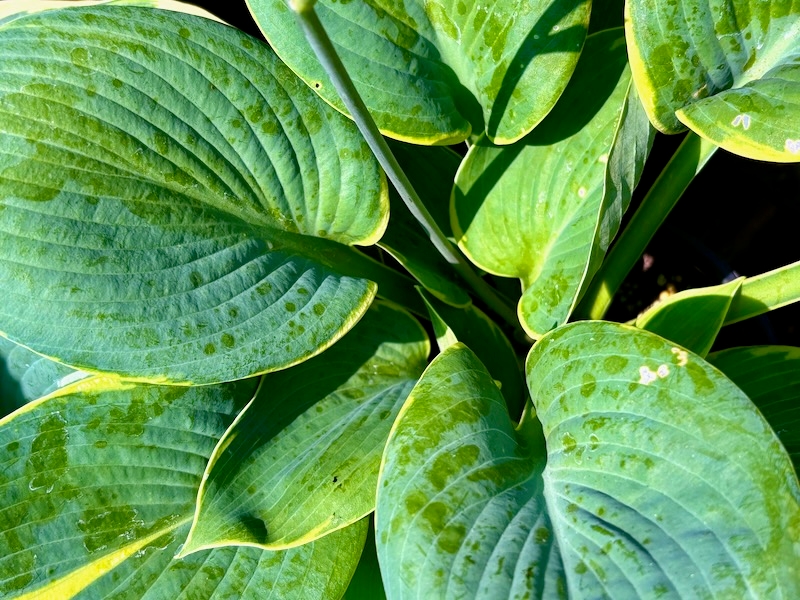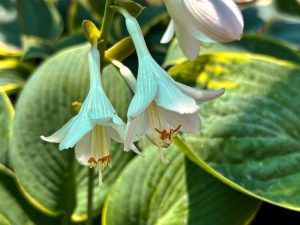Hosta sieboldiana ‘Frances Williams’: The Distinguished Plantain Lily
Hosta sieboldiana ‘Frances Williams’, also known as Plantain Lily ‘Frances Williams’, is a striking cultivar within the Hosta genus, part of the Asparagaceae family. This cultivar is celebrated for its large, variegated leaves and robust growth, making it a favorite among gardeners for shaded areas. Hostas, in general, are native to northeast Asia, including China, Korea, and Japan. Named after Frances Ropes Williams, an American horticulturist who discovered it, this hosta has become a staple in many shade gardens worldwide.
Description
‘Frances Williams’ is a large, perennial hosta that stands out due to its blue-green leaves with wide, irregular yellow margins that mature to creamy beige. This variegation adds a vibrant contrast to shaded garden spaces. Key characteristics include:
- Leaves: The leaves are thick, puckered, and broadly heart-shaped, measuring up to 12 inches long. They are strongly veined and contribute significantly to the plant’s ornamental value.
- Flowers: In mid to late summer, ‘Frances Williams’ produces pale lilac, funnel-shaped flowers that rise on scapes up to 30 inches tall. While the blooms are attractive, the primary appeal of this hosta lies in its foliage.
- Size: This hosta grows to about 32 inches tall and spreads up to 51 inches, forming impressive clumps over time.
Care Instructions for Hosta sieboldiana ‘Frances Williams’:
Light: ‘Frances Williams’ thrives in part shade to full shade, making it ideal for planting under trees or in other shaded garden areas. It can tolerate some morning sun but should be protected from the harsh afternoon sun to prevent leaf scorch.
Soil: This hosta prefers fertile, moist, and well-drained soils. Incorporating organic matter such as compost or well-rotted manure into the planting area will enhance soil fertility and moisture retention.
Water: Regular watering is crucial, especially during the first growing season to establish a deep, extensive root system. After establishment, water as needed to keep the soil consistently moist. Avoid overhead watering to reduce the risk of foliar diseases.
Mulching: Apply a thick layer of organic mulch around the base of the plants to help retain soil moisture, suppress weeds, and keep the root zone cool.
Maintenance:
- Pruning: After flowering, cut off spent flower stems to direct energy back to the foliage. Remove discolored or damaged leaves as needed to maintain a tidy appearance.
- Mulching: Heavy mulching in late spring will help suppress weeds until the hostas fully emerge.
- Fertilizing: Apply a balanced, slow-release fertilizer in the spring as new growth begins to promote vigorous growth and rich foliage.
Pests and Diseases: ‘Frances Williams’ is relatively slug-resistant, a common pest for hostas. However, slugs and snails may still occasionally cause damage. Use slug traps, barriers, or organic slug baits to manage these pests. Watch for other pests such as aphids or spider mites and treat them accordingly. Ensure good air circulation to prevent fungal diseases like leaf spots.
Propagation
Division: The best method for propagating ‘Frances Williams’ is through division. This is typically done in early spring or late summer:
- Preparation: Water the plant thoroughly the day before dividing to ensure it is well-hydrated.
- Digging: Carefully dig around the plant to lift the clump from the ground.
- Dividing: Use a sharp knife or spade to divide the clump into sections, each with several leaves and a portion of the root system.
- Replanting: Replant the divisions at the same depth they were growing previously, and water them well to settle the soil.
Landscape Uses
‘Frances Williams’ is a versatile plant suitable for various garden settings:
- Shade Gardens: Its large, variegated leaves brighten shaded areas and provide excellent ground cover.
- Underplanting: Ideal for planting under trees and shrubs, where its foliage can create a lush understory.
- Borders and Edges: Use it to define shaded borders and pathways.
- Containers: Large containers can accommodate ‘Frances Williams,’ adding vertical interest to patios and shaded corners.
- Wildlife Gardens: The plant’s structure provides shelter for small garden wildlife, while the flowers attract pollinators like bees and butterflies.
Toxicity: It’s important to note that hostas, including ‘Frances Williams,’ are toxic to dogs, cats, and horses if ingested. Gardeners with pets should take precautions to prevent them from eating the plant.
Conclusion
Hosta sieboldiana ‘Frances Williams’ is a distinguished and reliable choice for shaded garden areas. With its striking variegated foliage, ease of care, and versatility in the landscape, it continues to be a beloved plant for gardeners seeking to add texture and color to their shade gardens. By providing the right conditions and care, ‘Frances Williams’ will thrive and enhance any garden space for years to come.



